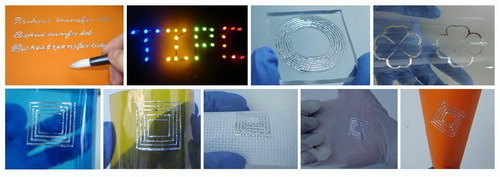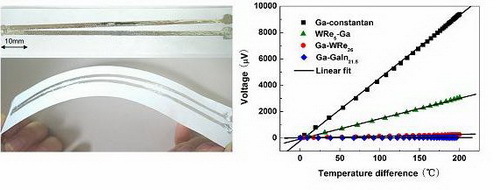Recently, researchers from the Institute of Physical and Chemical Technology of the Chinese Academy of Sciences and Tsinghua University have made breakthrough progress in the field of printed electronics, making direct handwriting of electronic devices on the surface of various flexible or hard materials a reality. Related research articles were published in the "Public Science Library • Comprehensive" published by the American Public Science Library (YX Gao, HY Li, J. Liu, Direct writing of flexible electronics through room temperature liquid metal ink, PLoS ONE, vol.7 (9): e45485, 2012).
This research establishes a new principle of electronic device manufacturing method, the core of which is to write the required conductors, wires and even the bottom from top to bottom on top of various substrates through different temperature liquid metal or its alloy ink Various functional electronic devices, sensors and integrated circuits. This method has shown wide application value in the fields of printed electronics, biomedical electronics, electromechanical industry and even energy. According to this method, researcher Liu Jing expressed the abbreviation of Direct Writing of Electronics based on Alloy and Metal Ink in English, and named it DREAM-Ink (also taken as "Dream Ink" "Meaning" technology.
The traditional electronic device printing process is usually more complicated, easily pollutes the environment, consumes time, consumes materials and consumes energy, so that the cost is very high. The direct-write printing method that can directly manufacture electronic devices on various substrates is expected to reshape the integrated circuit industry. However, the lack of high-performance ink has always been a shortcoming of the industry's development. Conventional conductive inks include the newly emerging electronic inks based on nano-gold / silver / copper, carbon nanotubes, graphene, etc. There are still complex preparation processes, high resistivity, wire formation needs to be achieved through complicated chemical reactions, and device molding and curing temperatures Unfortunately, the printing of existing high-temperature solders and other metals on flexible substrates will be greatly limited. In contrast, the WYSIWYG DREAM-Ink technology avoids the above difficulties. It is obviously different from the classic film-forming methods of metal thin films with high energy consumption and complicated processes, such as PVD and CVD. At room temperature You can directly print various films and even three-dimensional structures, which opens a convenient and low-cost way to make flexible electronic devices instantly. In the previous work, the research team established a method for preparing a variety of low-melting metal inks, and revealed the regulation of the wetting characteristics between the corresponding metal fluid and different substrates.
"Compared with the previous electronic inks, liquid metal or its alloy inks not only have the advantages of direct printing and writing, high electrical conductivity, but also show more unique features, such as wide application, moderate cost, and convenient preparation methods. This has laid the foundation for its large-scale popularization and application in the future. "Dr. Yunxia Gao (post-doctoral post, first author of PLoS ONE article) pointed out," This technology makes making circuits as simple as writing and drawing on paper. " She also pointed out that conventional brushes, special pens, ballpoint pens, etc. can be used as tools for drawing circuits, and through certain designs, any soft and hard base materials can be compatible with metal inks. Prior to this, the weak adhesion between the liquid metal and each interface has been the bottleneck restricting its practical application. After nearly half a year of hard work, Gao Yunxia and his postdoctoral tutor Liu Jing finally discovered the mechanism and successfully developed a high-performance material with a thermal conductivity of nearly three times the best commercially available thermal interface material. Due to the outstanding value of the results, The relevant papers were accepted for publication on the day of submission (YX Gao and J. Liu, Gallium-based thermal interface material with high compliance and wettability, Appl Phys A, vol. 107: 701–708, 2012). These developments have laid a solid foundation for the full application of DREAM-Ink.
Room temperature metal fluids are a kind of wonderful materials that are liquid, flowable and conductive at normal temperature and pressure. However, their applications in the fields of information, energy, medical health, electronics, etc. have been little known for a long time. As early as more than 10 years ago, Researcher Liu Jing realized the scientific significance and great value of liquid metal research, led the team to carry out corresponding basic and application exploration, and successively achieved a series of pioneering results, such as room temperature for high-performance computers Metal fluid chip cooling technology, metal fluid anhydrous heat exchanger that can be widely used in the energy field, low melting point metal phase change endothermic technology for mobile electronic devices, liquid metal energy automatic capture and power generation technology, and nano metal fluid materials, etc. Several very important new research directions, part of the work was selected as the only best paper award of the year by the international electronics packaging technology journal ASME Journal of Electronic Packaging, and was also selected as the cover article by Journal of Physics D: Applied Physics.
DREAM-Ink technology is brewed in long-term practice. The core idea has submitted the corresponding invention patent application in early 2011. Since then, it has been directly printable thermal / kinetic energy traps, microfluidic chips on paper, semiconductor devices, A series of invention patents have been formed in photovoltaic cells and even liquid metal printers. Researcher Liu Jing pointed out: "So far, the laboratory has successfully proved that metal or alloy inks that can be used for handwriting and epoxy resin, glass, plastic, silicone, paper, cotton, textiles, cloth, fiber and even human skin are all Highly compatible, which opens many important uses for the rapid design of flexible electronic circuits. Taking biomedical applications as an example, conformable electrodes can be formed after coating the corresponding metal ink on the surface of the measurement object near the heart, which is easy Elution, which will bring greater convenience to the measurement of ECG ECG signals and bioelectrical impedance and other physiological parameters, and there is a lot of room for further expansion. "
"Dream of ink" technology has universal significance. In fact, before the publication of the above PLoS ONE article, Liu Jing's group also proved the application value of this method in the direct printing micro temperature sensor. Li, Y. Yang, J. Liu, Printable tiny thermocouple by liquid metal gallium and its matching metal, Applied Physics Letters, vol. 101: 073511, 2012). This work first proposed and studied the thermoelectric effect between liquid metals and the interface between liquid metals and solid metals. As the first author of the article, Dr. Haiyan Li said, "The use of two paired liquid metals to write miniature thermocouples directly on the required substrate has brought greater convenience to the use. The corresponding technology is in biomass measurement, microfluidic devices, etc. It has important value. The experiment found that in the temperature range of 0 to 200 ℃, the thermoelectric potential between the interface of the two liquid metals or between the liquid metal and the solid metal shows a highly linear relationship with the temperature, which is very beneficial for the accurate measurement of temperature "To date, in the laboratory, the research team has also used DREAM-Ink technology to make transparent conductive films, antennas, RFID components, etc., which have all demonstrated significant practicality.
In general, the use of liquid metal ink is extremely simple, which indicates its better universal application prospects. As an emerging technology, "Dream Ink" has the potential to influence the current lifestyle of people. For example, new technology may change people's concept of paper in daily life-that is, it is no longer just a carrier of words, but also easy to integrate many electronic components, which may lead to personalized design of electronic devices (DIY: Do It Yourself) The trend helps promote the arrival of the personal electronic age; in addition, washable fabrics that can sense and emit light are no longer limited to imagination; electronic clothing printed with liquid metal films can generate electricity at any time in the sun; building walls or glass surfaces It can be directly coated with metal ink and related materials in a DIY way as LEDs or even solar cells, as an ornament or a device to capture light energy. At the same time, a non-traditional transformation will also take place in the fields of design, education and culture and art. Teachers and students will benefit a lot in the future-with liquid metal ink, the course teaching will become vivid and interesting, and students can do whatever they want The drawing of various objects is different from the traditional concept. The electrical, magnetic, acoustic, light, thermal, mechanical, chemical and other functions provided by DREAM-Ink painting can fully mobilize the various senses of the human body.
The next goal of the Liu Jing group is to develop more liquid metal inks at room temperature to meet various specific functional electronic devices, such as Lab on Chip, biomedical sensors, 3D antennas, thin film transistors, solar cell arrays, and radio frequency identification. Labels, flexible batteries and even integrated circuits are needed to expand this method to more industrial and commercial fields and even daily life. At the same time, the team is also stepping up the development of supporting liquid metal printers and styluses. They look forward to the general public's ability to use DREAM-Ink devices such as laser printers in the future. At that time, even those without electronic design experience could use the control software developed in advance and installed in the computer to print out the electronic devices they needed and even assemble the electromechanical system as they wanted. In this way, a quick production for family or friends A highly personalized e-card is no longer a difficult task.
Considering the scientific significance and major development prospects of DREAM-Ink research, in order to promote the progress in this emerging field, Liu Jing and his students recently published a 30-page forward-looking paper (Q. Zhang, Y. Zheng, J. Liu, Direct writing of electronics based on alloy and metal ink (DREAM Ink): A newly emerging area and its impact on energy, environment and health sciences, Frontiers in Energy, vol. 6 (4): 311-340, 2012 ), Systematically elaborated the basic principles and implementation methods of DREAM-Ink flexible electronic direct writing technology, as well as the scientific problems and technical challenges contained therein, specifically proposed a series of innovative strategies and analyzed several application cases, discussed the corresponding research and The possible impact of applications on energy, environment and health sciences in the future. "In fact, DREAM-Ink electronics is more important than the previous progress that has been achieved because it has derived many unprecedented scientific problems that need to be deepened. In this regard, domestic and foreign scientists, engineers and even a wider range of designers are urgently needed. Work together with users. "
Liu Jing believes that it is foreseeable that with the continuous advancement of research, "Dream Ink" will spawn a series of new-generation electronic engineering technologies that transcend traditional ideas.

Figure 1 Using liquid metal ink to directly write text, patterns, RFID tags or LED circuits on different substrates

Figure 2 Thermocouples (thickness 10 ~ 20μm) and thermoelectric temperature characteristics of film-type paper directly drawn by handwriting

Figure 3 Inductance, resistance, antenna or functional circuit printed directly by liquid metal prototype printing equipment
The Eyeshadow Brush can fully blend the Eyeliner with the Eye Shadow around the eye and under the eyebrow, so that the layered sense of color can be dulled. The amount of hair is moderate, and the amount of powder makeup is easy to control. The long handle design has excellent stability, which can easily show the delicate lines and let the color spread naturally. Can also be used to shape nose shadows.
Crease Brush,Shadow Brush,Eye Makeup Brushes,Eyeshadow Crease Brush
Henan Daxin Cosmetics Co., Ltd. , https://www.dx-cosmetics.com